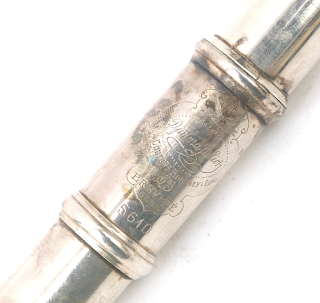Old and antique flutes
Call it crazyness but collectors are people of all times! Thanks to many of these persons we are able to discover the lines along which the developments of all kinds have come to these times!Information? Please mail me for contact: acakoevoets@kpnmail.nl
Thursday, August 10, 2006
Anonymous Instruments
PICCOLO / BOXWOOD FLUTE
 The midsection of this instrument that is crackfree!
The midsection of this instrument that is crackfree! These older instrument may not be the loudest
These older instrument may not be the loudestbut their sound is so sweet that even piccolo haters
will love it!
This flute has been made out of boxwood en therefore
a very light instrument. Boxwood is quite precious and
harder to find but its resonance is incredible: A great
sounding instrument. As often happens this is a so
called stencil instrument made for one of the many dealers.
BONNEVILLE AUGUSTE
Philipp Hammig Silver Flute
 Another picture of the Philipp Hammig.
Another picture of the Philipp Hammig.Wednesday, August 09, 2006
William Haynes Flute
Djalma Julliot Flute / Djalma Julliot Flute part (Main Section- silver plated)
(1858-1921) was a specialist of the transverse flute who was very
well known in the 19th century. When he started working under his
own name in 1894, he decided to expand the family tradition of
making keys for musical instruments, by starting with instruments
production. He chose to produce metal flutes.
Inventive and innovative by nature, he filed numerous patents
for various production techniques, and the era's top flautists like
Paul Taffanel (1844-1908) and Philippe Gaubert (1879-1941)
specifically sought out his instruments for their fine balance and
meticulous finish. In 1911, at the age of just 53, he sold his
business to Clément Masson (circa 1880-1956), Trotte (?-?) and
Eugène Lorée (?-?). The brand ceased operations in 1956.
Some interesting information can be found on a website by
clicking on this link:













































